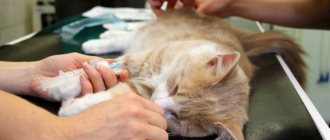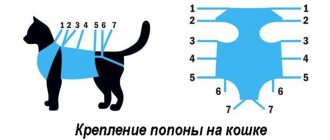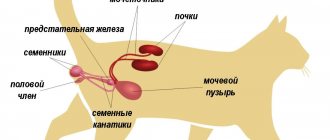By purchasing a small, beautiful kitten for family comfort and with the goal of instilling kindness and responsibility in our children and grandchildren, we eventually get an adult cat. Having become an adult, a cat, like any adult animal, begins to show its natural instincts, including those of the reproductive system. Transforming from a carefree playful kitten into a capricious cat, which, during sexual heat, stops listening to you, refuses food and seeks to escape from home in any way. Having run away from home and fulfilled your sexual instinct, often with a stray cat, after a few months he “gifts” you with a bunch of kittens, which for the most part you do not need, and you have a new headache, what about these brought, as people say in do "hem" with kittens. To prevent all this and do it in the most humane way, it is necessary to promptly sterilize your cat.
So, what is sterilization in a cat? Sterilization is the restriction of the function of the genital organs or the removal of reproductive organs. The goal is to deprive the cat of the ability to reproduce and adapt it to life with the owner.
What methods are there to sterilize a cat?
Today in veterinary medicine there are several methods of sterilizing cats.
- Ovariohysterectomy - this operation involves removing the cat's uterus and ovaries, through an incision along the linea alba or through a small incision on the side. This method is the simplest and is used by veterinary specialists in most clinics. By using this method, we completely eliminate the occurrence of future diseases of the uterus and ovaries in the cat.
- Ovariectomy - surgery to remove the ovary. After the operation, the cat loses the ability to reproduce and goes into estrus. The disadvantage of this operation is that the cat may subsequently develop diseases of the uterus (pyometra) and mammary gland tumors.
- Laparoscopy - this operation consists of removing the uterus and ovaries through a small puncture in the abdominal cavity. The operation is available in large veterinary clinics, because... the progress of the operation is monitored via a monitor.
- Tubal occlusion - an operation associated with ligation of the fallopian tubes, as a result of which the cat’s sperm cannot enter the cat’s uterine cavity.
- Medical sterilization involves temporarily suppressing sexual function through the use of special medications. Depending on the type of drug, the period of sexual “hunting” in a cat can be delayed by several weeks or months. The disadvantage of this method is that the risk of pyometra, mammary and ovarian tumors increases in the cat.
- Radiation or chemical - by irradiating the cat's ovarian area. This method is considered relatively safe, but at the same time there is a risk of irradiating other cells and developing cysts and tumors of other internal organs.
Today, the most common and safest method in veterinary clinics is the surgical method of sterilization.
How to properly prepare a cat for the procedure?
Here everything largely depends on its type. But we will describe preparation for the most common type of castration, surgical removal of the gonads. First of all, you should optimize your cat's nutrition. It is necessary to completely exclude heavy, fatty foods from the diet, and limit the amount of dry food your pet receives.
It is not recommended to castrate overweight cats, since their body reacts very hard to changes in hormonal levels as a result of the procedure. In addition, such animals have a greater than 90% chance of developing severe obesity in the future.
Very important! If your pet does not have an “athletic” build, be sure to put him on a diet a couple of weeks before surgery.
Neutered animals have very little need for nutrients and energy. If the cat is already accustomed to eating a lot, this quickly leads to its “swelling.” In turn, high weight is an almost 100% guarantee of the occurrence of pathologies of the cardiovascular system.
If you are giving your pet any medications (no matter what), be sure to inform your veterinarian about this before you begin preparing for surgery. It may turn out that they are incompatible with drugs used for anesthesia. And it’s better to find out about this before the operation, and not during it...
Benefits of cat sterilization
Sterilization has economic, preventive and therapeutic purposes and is often associated with the fact that the cat owner often does not have the opportunity, and sometimes even the desire, to raise kittens from his cat.
The behavior of an unsterilized cat during heat (estrus) is accompanied by aggressiveness; the cat becomes restless, unkempt, constantly howls and screams, calling for the cat, and takes measures to run away from the house in search of the cat. And having run away from home, he mates with any stray cat he comes across, who often suffer from various infectious diseases.
After sterilization, your cat becomes more obedient, and sterilization usually does not have any effect on its temperament.
Cat owners should keep in mind that sterilization carried out at an early age will not only save your cat from numerous diseases of the uterus and ovaries, but will also save you from future inconveniences that owners of an unsterilized cat experience.
Summarize:
- a sterilized cat will be less distracted by its sexual instincts and will devote more time to you and your family members;
- a sterilized cat is less likely to wander and get injured while searching for its partner;
- has a lower risk of cancer and pyometra, diseases that most often affect unsterilized cats;
- Considering that during the period of heat, a cat can defecate in inappropriate places, thereby damaging carpets and furniture. With sterilization you will get rid of this;
- You will be freed from the financial and spiritual costs associated with treating a pregnant cat, as well as illnesses when feeding your kittens. All this costs a lot of money, caring for growing kittens due to the fact that you will have to monitor their feeding, vaccination, fight worms, and also deal with the issues of selling them in good hands.
General information
Historically, the term “castration” refers exclusively to the procedure of physically “removing” the testes from the scrotum. But in fact, this interpretation is incorrect. It would be more correct to say that castration is a procedure that allows you to temporarily or permanently suppress a cat’s libido, reduce or completely eliminate the process of spermatogenesis. But the ways in which this is achieved can be very different. In “classical” cases, the testes are actually excised, but today gentle methods of castration of cats are increasingly used, in which conventional surgical intervention is no longer required.
Until recently, all types of castration were exclusively surgical and were divided into open (bloody) and closed (bloodless) methods. Today the classification has become wider. There are surgical and medical methods.
Many experts believe that castration should be divided into the following types:
- Surgical. As in previous times, it is divided into two subtypes - closed and open.
- Medication. Most often, this method is used for temporary castration of cats. To ensure that the animal does not pay attention to cats for some time, an implant is surgically implanted under its skin, which gradually releases special chemicals that inhibit the production of sex hormones and, accordingly, spermatogenesis.
- Chemical method. In this case, drugs are injected directly into the testes to promote atrophy of the glandular tissue of the organ. Let us note that this method is either not used in our country at all, or is used in extremely rare cases.
- Radiation castration. As the name suggests, the testes are irradiated by a source of gamma radiation. The cells responsible for spermatogenesis completely die, eventually being replaced by scar tissue.
I would like to note that for some reason detailed classification is not common in domestic veterinary periodicals. Most often, all castration methods are divided into two types: surgical and chemical, and the latter includes both truly chemical methods of sterilization and the radiological variety, as well as medicinal methods. This is not entirely correct and creates unnecessary confusion.
At what age should a cat be spayed?
A cat can be sterilized at any age, but the ideal age for its owner is considered to be 7-9 months. Since cats have an induced type of ovulation, i.e. without stimulation, which occurs in a cat during copulation with a cat, the follicle will not burst and the egg will not come out of it, as a result, this will lead to the development of a vesicle (cyst), and when there are many of them, to polycystic disease. Sterilizing your cat at an early age will prolong the life of your pet.
We often hear the question from cat owners: is it possible to sterilize a cat during estrus?
Practicing veterinarians have different opinions on this. Some believe that it is possible to sterilize an animal, others refer to the fact that a cat that is operated on while in heat will have a more difficult recovery from anesthesia, and the healing of the surgical suture will be more difficult. Based on this, most veterinary clinic specialists recommend that their patients undergo planned sterilization of their pets 2 weeks before the onset of estrus, or 2 weeks after its end.
Alternative methods of castration
In addition to the surgical method of intervention, there are also medicinal and chemical methods of castration of animals. Their purpose is also to suppress the cat’s sexual activity.
The chemical method of castration involves suppressing the function of the testes by irradiating them. Radiation doses are strictly controlled and do not exceed the permissible threshold for exposure to the body.
However, not all doctors support this procedure. There is an opinion that radiation, even in small doses, can lead to irreversible changes in the tissues of the genitourinary system and the development of tumors.
The medication method is a temporary measure. Within a few months after administration of the drug, the cat’s reproductive function is restored and the procedure has to be repeated.
Practice shows that this method is not guaranteed to be effective. Even after measures have been taken, the animal may remain reproductively active.
Due to the disadvantages of alternative methods and their negative consequences for the health of the pet, most owners opt for the standard and most reliable type of castration - surgical.
Where is the best place to sterilize a cat?
It is best to carry out cat sterilization surgery at home. Fortunately, there are a large number of such advertising services from veterinary clinics and private practicing veterinarians. When sterilizing at home in a familiar environment for the cat, your cat is not exposed to additional stress. You are freed from all the difficulties associated with transporting your cat to the veterinary clinic and back. All this will have a positive impact on the cat’s postoperative rehabilitation. But still, most cat owners carry out sterilization in veterinary clinics, where the doctor has more opportunities to cope with any unforeseen complications during the operation.
Cost of the operation
For owners planning to emasculate a cat, the cost of the procedure is of interest. This table shows approximate prices for operations in different regions.
| City | price, rub. | |||
| Healthy animals | Cryptorchids | |||
| min | max | min | max | |
| Uryupinsk | 650 | 650 | – | – |
| Rostov-on-Don | 500 | 2500 | 1000 | 2500 |
| Kazan | 1000 | 1800 | 2000 | 3800 |
| Moscow | 500 | 3000 | 2000 | 4500 |
Some clinics are most likely lying; the price of 500 rubles apparently only involves the operation, without the cost of medications. There is some relationship between the cost of services and the standard of living of the population.
The owner of a cat who has decided to castrate should not delude himself. He will have to spend much more money on diagnostic studies, vaccination, deworming, etc. He has to pay for the pleasure of communicating with an affectionate animal.
Despite the admonitions of animal rights activists, castrating a cat that is doomed to spend its entire life in an apartment is a relatively humane act. An unemasculated animal, obeying the call of nature, is capable of causing a lot of negative emotions to its owners and neighbors. Therefore, animal lovers have little choice. Castrate a cat or get another animal.
Video
Preparing a cat for surgery
- A few days before surgery, the cat needs to be dewormed for helminthic infestation.
- Before sterilization, you must keep your cat on a 12-hour fasting diet.
- Your cat must be clinically healthy.
- A month before surgery, the cat should be vaccinated against feline infectious diseases common in the area. Since when you visit a veterinary clinic, where you usually go with sick animals, your immunity weakened by the operation, you can catch some kind of infection.
About proper preparation of the room
Of course, achieving sterility “like in a clinic” is virtually unrealistic, but there is no strict need for this. However, surgical removal of the testes does not imply the need for abdominal surgery (if it does, as with cryptorchidism, then such sterilization should not be performed at home). So how to properly prepare a room for an operation, and in which room is it best to perform it?
Firstly, the bathroom is ideal for this. Of course, not combined with a toilet. In this case, the tiles are thoroughly washed with disinfectants and rinsed with clean water. It is advisable to do this at least twice. After cleaning, the room is thoroughly dried and cannot be used for its intended purpose until castration.
But what if you simply don’t have a bathroom at home? In this case, you can use any other room. The main thing is that it is not too large (it is easier to rinse). If possible, it is necessary to remove from the room all upholstered furniture, bedspreads, carpets and other items that are “dust collectors”. Ideally, it is necessary to leave only a table on which the cat will be castrated at home.
Information about the operation - cat sterilization
Let's look at the most common cat sterilization operation.
Total ovariohysterectomy. Before the operation begins, the veterinarian saves a small area of fur on the right side, then treats the surgical field. Through a small incision 3-5mm long, the uterus and ovaries are removed and then completely removed. After the operation, several stitches are placed on the skin. With this method, the operation is practically bloodless and less traumatic for the animal. The operation is performed under general anesthesia and is painless for the cat.
Indications and contraindications
Castration is allowed from 6 months. Operation at an earlier stage is unacceptable.
It is by 6 months that all organs and systems of the animal begin to form. Such manipulation will not delay the kitten’s further growth. Intervention in the endocrine system before this time is fraught with pathologies in the development of the animal.
Caring for a cat after sterilization
If you had your cat sterilized at a veterinary clinic, then the operated animal may be given to you in a state of anesthesia or slightly recovered. Typically, veterinary specialists hand over the operated animal in a postoperative blanket or protective collar, which can protect the postoperative sutures from licking. If your cat is aggressive, then ask the specialists to trim its claws, which will further protect you from its claws during post-operative care.
Usually after surgery, visitors are advised to sit in the veterinary clinic for 30 minutes to ensure that the cat is not bleeding externally from the surgical suture.
In large veterinary clinics, owners of operated animals are given recommendations on the clinic’s letterhead by veterinary specialists on how to care for their cat after surgery.
After the operation, especially in the cold season, you should get to your home as quickly as possible. The operated cat must be placed in a spacious carrier and covered warmly. Under no circumstances should you carry an operated cat home in your hands because... Having recovered from the state of anesthesia, the cat is in an inadequate state and can break out of your hands and start running around the car and causing an accident.
During transportation, as well as when the cat is immobile, it is advisable to place it on its side so that if vomiting occurs, it can come out freely and not cause blockage of the bronchi. Air should flow freely to the cat's nose.
Having arrived home, the cat must be placed in comfortable conditions for it - on soft bedding, wrapped up, the air temperature should be 22-24°C.
If the veterinary clinic did not give you painkillers after the operation, you must give this injection yourself (you cannot give painkillers orally until a normal swallowing reflex appears). Check whether the surgical suture is bleeding. The discharge of ichor from the suture is not dangerous for the animal.
Some cats may be slightly restless and agitated by external stimuli after surgery. This is temporary, so you can leave her in her carrier or in a separate room.
After completely recovering from the state of anesthesia, the cat will try to get rid of the collar or blanket by any means. You should not allow this, if, nevertheless, she manages to do this, she will lick the stitches and the inflammatory process will begin and you will again have to apply a blanket or collar plus an additional course of antibiotics.
Pet's behavior after surgery
Based on the advice of experienced veterinarians, your pet will need some time to regain its strength after castration. Typically, the recovery period in cats lasts only 1-2 days, during which the pet is in a sedentary and relaxed state. Your cat may be completely averse to eating any food, a process that may trigger vomiting. After castration, the pet will walk very unsteadily and slowly. But these are, perhaps, all the consequences of the operation, which quickly disappear, so there is no need to worry too much.
Modern veterinary medicine allows the procedure to be carried out quickly and without any special risks, if the anesthesia and age of the cats are selected correctly. During this period, the cat will need your support and attention more than ever. You need to carefully monitor your pet, because due to loss of coordination, he may accidentally fall from a height and cause some injury to himself. It is also necessary to take care of the cat and make sure that it does not suddenly freeze. To do this, during recovery days, we advise you to cover him with a blanket and place him near a warm radiator. As veterinarians write in their advice, approximately 5 hours after castration, it is necessary to give the pet a drink of clean water. Of course, this operation will exhaust the animal.
When should a cat’s appetite and natural functions be restored?
A sterilized cat's appetite usually returns within the first two days. If your cat’s appetite does not recover for a long period of time, then you need to immediately contact a veterinary clinic. Since lack of appetite indicates some kind of disruption in the functioning of internal organs.
Your cat will usually urinate less in the first days after surgery. The appearance of an increased or decreased amount, or even the absence of urination, indicates disorders in the genitourinary area and requires immediate contact to a veterinary clinic for a thorough examination by a veterinary specialist.
Sometimes some cats may experience constipation, which is usually a reflex. Due to constipation, the cat becomes lethargic, refuses food offered, becomes weak and tends to sleep more. To relieve constipation, veterinary experts recommend taking a laxative to owners. For this purpose, a harmless drug such as petroleum jelly is used for cats in an amount of 5 ml per 5 kg of animal body weight, using it every 8 hours until a positive effect is obtained.
Myths about castration
There are many prejudices about neutering kittens. Let's look at the most popular ones.
A cat must give birth at least once
In fact, research shows that cats spayed before their first heat are healthier. Unneutered cats are at risk of developing uterine infections or mammary cancer.
Neutered animals are overweight
Excess weight does not appear due to castration, but due to poor nutrition and a sedentary lifestyle. Play active games with your pet more often. Feed your pet food that meets its biological needs, such as SUPERPET diets. Cats are obligate carnivores, the basis of their diet is animal protein. Their body is not adapted to a high-carbohydrate diet.
Castration is harmful to the health of pets
As we have already found out, castration not only does not harm health, but is a prevention of some serious health problems.
The cat will feel inferior after castration
Castration does not affect a cat's sense of self in any way. They simply don’t have it, so after the operation nothing will change for them. But the risk of running away in search of a partner will be reduced.
Sterilization and castration of a kitten are safe procedures. The main thing is that they are carried out by a certified veterinarian in the clinic. After castration, your pet will become calmer and the risk of certain diseases will decrease. And in order not to worry about excess weight, we recommend feeding your pet with a species-typical food, for example, SUPERPET.
Increase in body temperature after sterilization of a cat
Depending on the body's resistance, some cats may have a body temperature above 39°C in the first 5 days after sterilization. At the same time, an increase in body temperature does not necessarily mean that after visiting the veterinary clinic, your cat has caught some kind of feline infection, or is one of the symptoms of an upcoming surgical infection. The resulting inflammation, accompanied by an increase in the cat’s body temperature to 39.5°C, is normal. If the cat’s body temperature rises much higher, then it is necessary to urgently contact a veterinary clinic.
Healing of surgical suture after sterilization
After sterilization, a few drops of blood or ichor (diluted blood) may appear in the suture area of the cat. If you notice that blood begins to leak in the area of the suture, then to stop it you will only need to apply an ice pack to this place.
After the operation, the suture site may turn red, small bruises may appear under the skin in the suture area, and the skin itself becomes swollen. This should not worry you, as it is a sign of inflammation - a response to surgical trauma. By the 5th day after the operation, all this will pass, but if the skin at the incision site remains wet, then you will need to contact a veterinarian, or if it is not possible to treat this area with antibacterial ointment (Levomekol). If the cat's seam is dry, then everything is fine.
Complications after castration
As a rule, cats, including mature ones, easily tolerate castration. Moreover, neutered pets live on average a couple of years longer compared to their non-neutered counterparts. They are less likely to develop leukemia, peritonitis, or the immunodeficiency virus.
And yet there are complications. They most often occur against the background of an untreated disease. Anesthesia provokes pathological processes, resulting in an exacerbation.
There is an opinion that castration leads to urolithiasis. In practice, this could not be proven unambiguously. Most likely, the issue here is not so much the absence of testes, but rather an incorrect diet and metabolic disorders. Cats neutered in adulthood may suffer from cardiovascular diseases due to general wear and tear of the body.
Anesthesia and anesthesia
The procedure can be done under local anesthesia with infiltration and conduction administration of 0.25-0.5% lidocaine. However, the method of castration of cats often requires anesthesia with the animal positioned belly up.
Anesthesia
There is always a threat of cat death due to anesthesia, especially with a high dose. In kittens, the risk of death is also no less, but in pets over 7 years old, the threat of a fatal outcome is rapidly increasing. In addition, English breeds, Maine Coons, and Scottish Folds have a tendency to have a strong reaction to anesthesia. It is unsafe to anesthetize cats with defects or insufficiency of the cardiovascular system.











